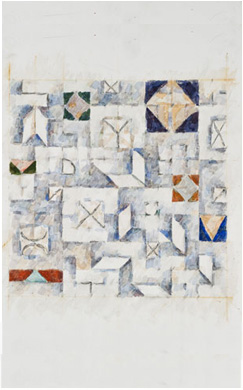
WRITINGS
It may be too monotonous, but I seem to be striving for not a monotony, but an equanimity where each element is contradicted by another element, where the words good, bad, up, down, neg., pos., color vs. no color lose their meaning in something more important. What that something is, I find very hard to verbalize perhaps a state of mind is as close as I can come up with right now.H.N. Journal
March 23, 1972
Wallace Stevens says that the "poet's" imagination must somehow create a "non-geography" in the mind. The imagination must be "a violence from within that protects us from a violence without."
H.N. Journal
July 10, 1965
My new paintings are not depictions of nature, but "equivalences" for that crystalline quality of light that is so pervasive in New Mexico. That light for me is a visual metaphor for an interior state of clarity - the paintings attempt to represent a state of mind.
The Magic Square series is about two concerns of mine: a mystical involvement with numbers and a search for an image which has the inevitability of an organic structure of nature. Some magic squares have titles: names of places that evoke a ritualistic, talismanic feeling. Primeval names of an ancient land.
I went from the sea to the desert.
Clarity of space
whiteness of light
color of no color.
Timeless, vast spaces where the mind draws inward.
H.N. Journal
April 30, 1974
Myself is what I wear:
I keep my spirit spare.
Roethke
H.N. Journal
September 29,1975
"Metaphor is the very substance of poetry;" without it, "there would have been no bridge whereby to cross from the minor truth of the seen to the major truth of the unseen."
from the essay "The Chinese Written Character as a Medium for Poetry" in Instigations, Freeport, NY, 1967
H.N. Journal
July 31, 1980
Return to Jerusalem
Light-feeling of Ancient Stones
containing spirit
Home to Ancient temples
5000 years of ancestors
Arches echo the light.
Tombs on Mt. of Olives
gleaming like bones in
the dry air.
Air breathes of sages,
martyrs.
A different time or
different place calls to
some atrophied but not
quite dead feeling.
They live in my bones.
H.N. Journal
Feb. 1986
It is clearer to me, more than ever before, that my paintings are meditations on this "hidden unity," the connection between the world of my senses, what I see, and how this material is translated into a painting which expresses the duality of opposites, although exploring relationships until a "quivering" relationship results in the painting - a completeness not seen, but felt in nature. The lines are related to script--Chinese, Phoenician, Hebrew--where the characters could possibly express a feeling, a "pictograph" of feeling.
H.N. Journal
July 31, 1980
Geometry is the structure of the fabric of nature. Look into that flower where lies the deep symmetry of God. Behold for we are like shadows on the face of the earth fleeing with great swiftness as clouds sent across the sky.
Looking into the transparent vividness of the sea as it laps at my feet. I feel the sand dragging at my toes
wash your brushes
enter the sea labyrinth
H.N. Journal
June 30, 1981
Objects have no reality for me unless they are in agreement with each other and with myself. When one achieves this harmony, one arrives at a certain spiritual
non-existence I can only call it a state of peace--that makes everything possible and right. Life then becomes a continuous revelation.
This is true poetry.
-G. Braque
H.N. Journal
Feb. 3, 1989
Reading the essay on Diebenkorn by Elderfield, MOMA. He constantly refers to Wallace Stevens "Descriptions Without Place." This was a title I used for a group of paintings in 1965.
I found "The Necessary Angel--Essays on Reality and the Imagination" by Stevens and am in the process of reading them. So, almost 25 years later, I have returned to a place in my imagination. The circle is complete.
"The mind has added no thing to human nature. It is a violence from within that protects us from a violence from without. It is the imagination pressing back against the pressure of reality. It seems, in the last analysis, to have something to do with self-preservation; and that, no doubt, is why the expression of it, the sound of the works, helps us live our lives.
Human consciousness is in perpetual pursuit of a language and a style. To assume consciousness is at once to assume form. Even at levels far below the zone of definition and clarity, forms, measures and relationships exist. The chief characteristic of the mind is to be constantly describing itself."
-Wallace Stevens, September 1, 1989
H.N. Journal
Feb. 3, 1989
